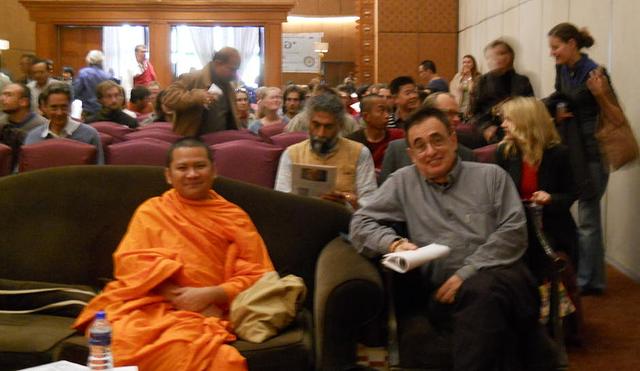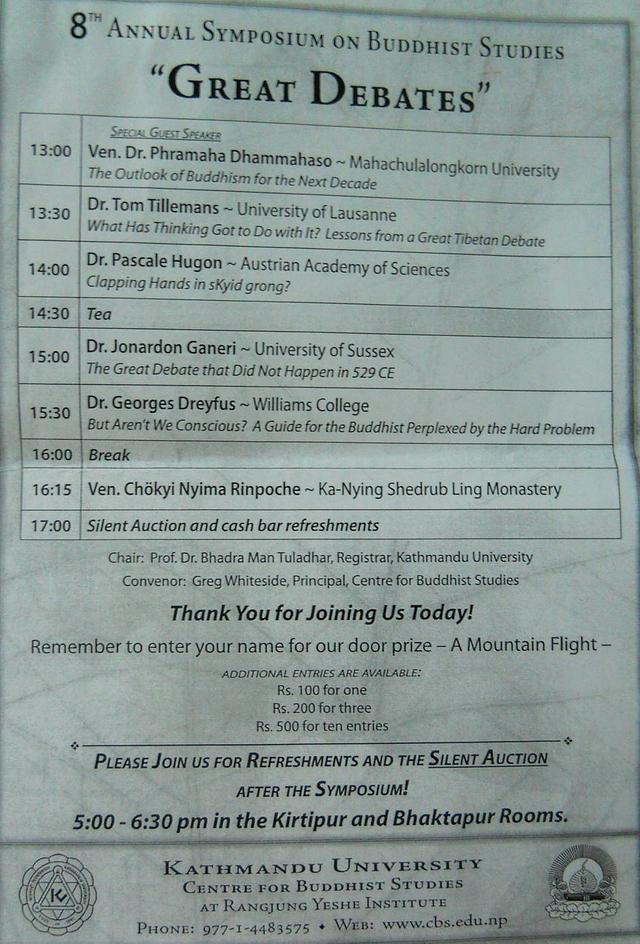สถานการณ์พระพุทธศาสนาในทศวรรษหน้า
ตามที่ศูนย์พุทธศาสนศึกษารังจุง โยเช (Rangjung Yeshe) มหาวิทยาลัยกาดมันดุ ได้มีหนังสือถึงอธิการบดีมหาวิทยาลัยมหาจุฬาลงกรณราชวิทยาลัย เพื่อนิมนต์ผู้เขียนไปปาฐกถาพิเศษ (Special guest speaker) วันที่ ๑๑ ธันวาคม ๒๕๕๓ ในหัวข้อเรื่อง “สถานการณ์พระพุทธศาสนาในทศวรรษหน้า” (The Outlook of Buddhism for the Next Decade) ณ โพธนาท เมืองกาดมันดุ (Kathmandu) ประเทศเนปาล ภายใต้หัวช้อหลัก “Great Debates” นั้น เพื่อให้เกิดการแลกเปลี่ยนองค์ความรู้ในเชิงวิชาการ ผู้เขียนจึงนำเนื้อหาจากการปาฐกถาพิเศษมานำเสนอดังต่อไปนี้

It is certainly true that there are several issues to address in a perceived crisis situation. For example, in a situation where the continuity of the Buddhasasana is challenged, some of the notable issues are: the declined number of the Bhikkhu Sangha; unethical conversion and globalization. Of course, these seem to be the challenging issue which required our urgent attentions.
The disciples of the Buddha have spread his teachings into neighboring and distant nations. These travelling noble-disciples had to adapt to different localities, learn their ways, and express the teachings of the Buddha using phrases and concepts that these distant people could comprehend. There is evidence of this type of missionary activity in my own nation, where the Brahmajala Sutta and Cūḷahatthipadopama Sutta were historically recorded as being taught in our lands in order to turn the local leadership away from their philosophically unsound views. Learned political leaders, learned religious leaders, learned householders and learned philosophers – all converted to the teachings of the Buddha.
Our societies are composed of several spheres: the political sphere, the economic sphere, the social sphere, the religious sphere, the domestic sphere, and whilst these spheres overlap, there are also more external spheres which impinge upon our internal affairs. All of these spheres are connected, in ways one might liken to the international Olympics logo or to links in a chain, as in dependent origination, a cyclic-connection of chains binding people to the world, known as samsāra.
Therefore, we have established Buddhist associations to assist with the development of the religion, which will influence societies where our members reside. We encourage the development of our Buddhist leaders and professors, as they engage daily in activities as simple as teaching the next generation of future leaders: students and children. The Buddha told Mara that his mission would not be complete until he had expert-disciples in the four-assemblies – and when this was established, he was able to attain the mahāparinibbāna, following his successive jhanic-endeavors. There are other Buddhist organizations that serve as alternatives to existing social structures. Buddhists can set up political parties; Buddhists can set up educational institutions; Buddhists can establish banking institutions; Buddhists can establish social-services and protection agencies. Buddhists can read their sacred texts – the Tipitaka, and seek and develop other principles that may need nurturing, dependent on the individualized condition or circumstance. I would ask, then, two questions:
1. How can Buddhism exist and continue?
When the Buddha became enlightened, he would have been content to meditate peacefully, but was persuaded by compassion to teach for the benefit of society. When this became too much for one great man, disciples were trained to speak on his behalf. The Sangha was formed, and selected members of the Sangha were sent on missions to spread the Dhamma into other lands. Modern Buddhists often wonder why Buddhism was conceptually eliminated in the land of its birth, despite being the most beneficial social-guidance philosophy or what some would call a religion. Today, Buddhism is back in the land of its birth, and is even spreading again, from these new seeds. Our socially-sound or strong institutions ensure the continuity of Buddhism – although the path has not been easy for many of us.
However, our world in the present time is facing various difficult circumstances, such as political crisis, environmental crisis, economic crisis, starvation and so on. How can Buddhism give hope, love, inspiration and dreams to those who really need them? The question facing Buddhism today is an essential dilemma. Can Buddhism accommodate itself to nationalism and the modern situation, which are seemingly the very opposite of Buddhist doctrine? If Buddhism does not adapt the Buddha’s teaching to respond to the modern problem, it will become a cultural fossil. If it adapts too much, it becomes adulterated and loses its essence and integrity. How, therefore, should Buddhism interact with modern systems in such complex situations?
2. How can Buddhism adapt to various circumstances in the modern world?
The effects of capitalism, both political and social, are beset with conflicts and have caused severe violence throughout the whole of Thailand. This affects the progress monks can make in the interpretation and dissemination of Buddhist teaching. In Thailand, Buddhists put great effort into interpretation and dissemination, by using rationale. They use rationale as an important tool to explain the Pali canon, in order that it will create a set of ethics that fit the original teaching.
However, critical study of political, economical, social, environmental and science issues has led to the realization that these matters are more complicated than they were in the past. This is because, in the past, Thais mostly lived in an agricultural society, so their world view and life view was not as complicated as that of an industrialized society.
The monks of the new movement have tried to explain and analyze Buddhism in its social and political dimensions. Thus their interpretation and dissemination have reflected the truth that Buddhism has never been separable from the social and political arenas since the Buddha's time. Hence the progress the monks’ interpretation and dissemination will make in the three areas that form the basis of this study: (1) the practice of linking the internal and external areas (2) the participation of the layman in society and (3) the participation of the monks in all areas.
The interpretation and dissemination carried out by progressive monks and conservative monks are different in some points. The first of these points is that the progressive monks will focus on pragmatism in order to connect the spiritual and social aspects of society. However, the conservative monks emphasize only the spiritual dimension, rather than social dimension. The other main point is that the progressive monks want to interact with a larger group of people, as is show by the horizontal line, but the conservatives only want to interact with a limited group, as in the vertical line.
However, the world view and life view of the progressive monks are more in keeping with the present situation, which modernization, including globalization, is rapidly and continuously changing. The most-needed monks belong to the horizontal group rather than the vertical. This touches on some complicated problems of the present day and needs the participation of lay people. Participation in the activities of the progressive monks are noted as well-suited and necessary to both doctrine and discipline (Dhamma and Vinaya).
The aforementioned question is analyzable in terms of the role and principles of the doctrine and discipline of the progressive monks. It has been found and demonstrated that they fit the Buddha's teaching and the early Buddhist Order in behavior and performance. The key indicator here is that the Buddha had a good relationship to both Buddhists and other competitors, such as Brahmans and Jhanas. The Buddha’s activities had parallel dimensions of the spiritual and the social. This is witnessed by the Buddha’s teaching, “You should all go in order to help to convey happiness to the people.
Finally, the progressive monks have to understand or should try to understand the participation in the world view and life view of laymen. It is necessary that monks must concentrate or have consciousness all the time. Otherwise, they will fall into the traps of conflict and choosing sides. Buddhism will lose confidence and faith, so the most important issue must be the monks' suitable behavior or performance rather than the participation of the people or society.
To sum up, what is the outlook for Buddhism in the next decade? This is the major theme that we are discussing. We have seen what the world has given us, now we must be the ones contributing to the world, so it is our aim to be the future leaders of the world, because other global leaders have only brought chaos and destruction. This is what Buddhism does best: empowers an individual to overcome adversity while developing compassion. With the powerful doctrines that inspire and guide all of us, Buddhism has secured its position as the most beneficial doctrine to guide and protect both ourselves and our environment.




ความเห็น (7)
นมัสการพระคุณท่าน
มาแสดงความศรัทธาในพระคุณท่าน ที่มีภูมิรู้ ภูมิธรรม ภูมิฐาน ขอรับ
ท่านผอ.
ไม่ได้พบกันนานเลย หวังว่าผอ. คงมีความสุขกับการทำหน้าที่ เพื่อเด็กเยาวชนของชาติในถิ่นยโสธร ขอให้กำลังใจต่อการทำหน้าที่ และพานพบแต่สิ่งดีๆ ตลอดไป
เจริญพร
โลกานุกมฺปาย หิตาย สุขาย สเทวมนุสฺสานํ, สทา โสตฺถิ ภวนฺตุ เตฯ

กราบนมัสการพระอาจารย์ ครับ
แวะมานมัสการพระคุณเจ้าครับ
ว่างแล้วจะกลับมาอ่านโดยละเอียดนะครับ
[[ddlink]]
watch the fashion show extreme elegant certain not to mouth form a very simple
